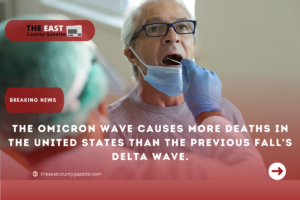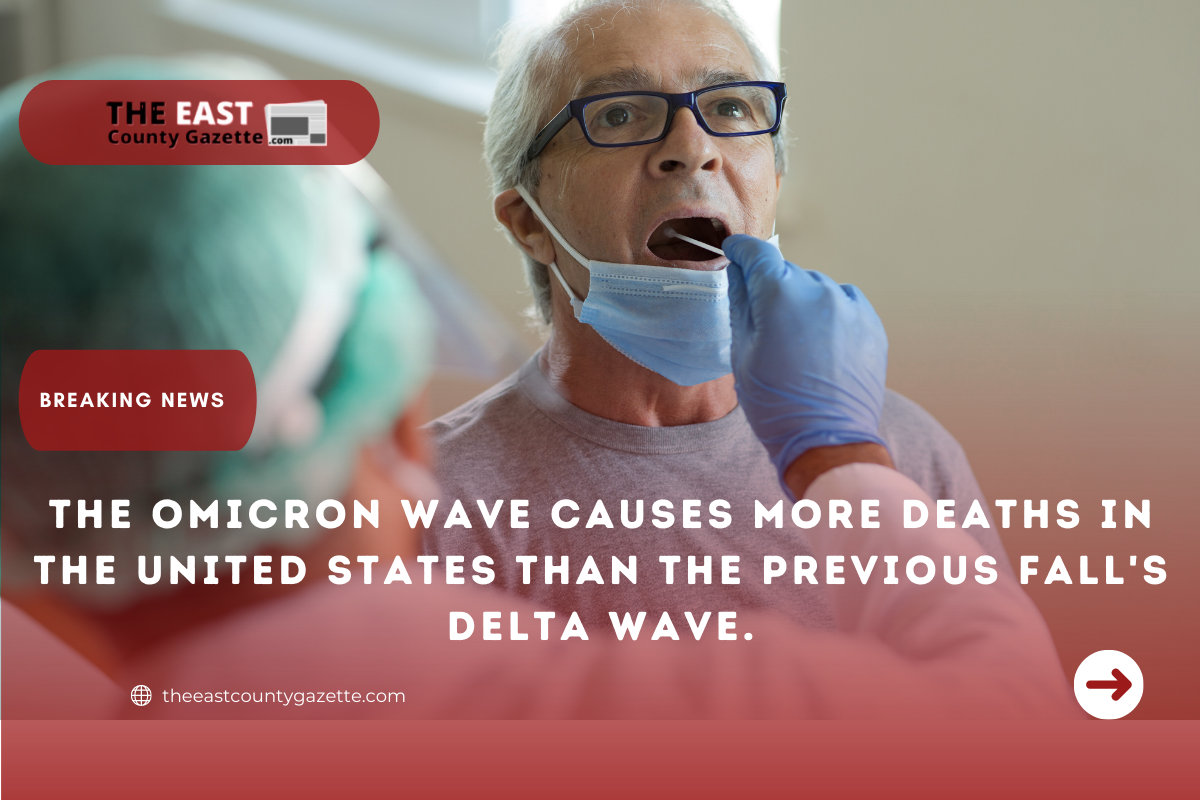Omicron, a highly contagious coronavirus variant that is sweeping the country, is driving the daily death toll in the United States higher than it was during last fall’s delta wave, and the number of deaths is expected to continue to rise for several days or even weeks.
Since mid-November, the seven-day rolling average of daily new COVID-19 deaths in the United States has been increasing, reaching 2,267 on Thursday and surpassing a previous high of 2,100 in September, when delta was the predominant variant of the virus.

According to current estimates, omicron is responsible for nearly all of the viruses currently circulating in the United States. In addition, even though it causes less severe disease in the majority of people, the fact that it is more transmissible means that more people are becoming ill and dying as a result of the virus.
According to Andrew Noymer, a professor of public health at the University of California, Irvine, “Omicron will push us over the one million death mark.” “That is going to cause a lot of introspection.” The question of what could have been done differently and how many of the deaths could have been avoided will be discussed extensively.”
The average daily death toll has now reached the same level as it was in February of last year when the country was slowly easing off the pace that had brought it to an all-time high of 3,300 deaths per day.
According to an AP-NORC poll released this week, more Americans are taking precautionary measures against the virus than they were before the omicron outbreak. However, many people, exhausted by the crisis, are attempting to return to some semblance of normalcy in the hope that vaccinations or previous infections will provide them with protection.
Researchers agree that the symptoms of Omicron are often milder and that some infected people show no symptoms at all. However, it, like the flu, has the potential to be fatal, particularly in the elderly, those with other health problems, and those who have not received a vaccination.
The Director of the Centers for Disease Control and Prevention, Dr. Rochelle Walensky, stated this week during a briefing at the White House that “milder” does not necessarily mean “milder.”
Chuck Culotta was a middle-aged man in good health who owned and operated a power-washing business in Milford, Delaware, until recently. His symptoms began to manifest just before Christmas when an omicron wave ravaged the Northeast, and he was diagnosed on Christmas Day after testing positive.
He passed away less than a week later, on December 31, just nine days shy of his 51st birthday, in a car accident.
Todd, his brother, explained that he had chosen not to be vaccinated because he was concerned about the vaccine’s long-term effects.
The shots were administered during the summer, and Todd Culotta, who received them, explained that he was unsure whether it was the right thing to do.
In one Kansas city-based urban hospital, 50 COVID-19 patients have died this month, and more than 200 others are currently being treated. Video from the University of Kansas Hospital’s morgue in Kansas City, Kansas, showed bagged bodies in a refrigeration unit, with one white body bag marked with the word “COVID” by a morgue worker.
According to Ciara Wright, the hospital’s decedent affairs coordinator, “this is a real situation.” “Our main concern is, ‘Will the funeral homes be able to respond quickly enough?'” We have access to a refrigerated truck, which is convenient. It’s something we don’t want to use if we don’t have to.”
Almost every day in January, according to Dr. Katie Dennis, a pathologist who performs autopsies for the healthcare system, “the morgue has been at or above capacity,” “which is definitely unusual.”
There have been more than 878,000 deaths in the United States, making it the country with the highest COVID-19 toll of any country.
According to the COVID-19 Forecast Hub, deaths will increase at a faster rate in almost every state in the United States during the coming week, although deaths have reached a peak in a few states, including New Jersey, Pennsylvania, Iowa, Maryland, Alaska, and Georgia, in recent weeks.
According to the Centers for Disease Control and Prevention (CDC), new hospital admissions have begun to decline across all age groups, and a decrease in deaths is expected to follow.
“In a pre-pandemic world, we see 10,000 to 15,000 deaths during some flu seasons,” says the author. “With COVID, we see that in the course of a week,” said Nicholas Reich, who aggregates coronavirus projections for the hub in collaboration with the Centers for Disease Control and Prevention.
Professor of biostatistics at the University of Massachusetts, Amherst, Reich described the toll as “staggering and very humbling,” adding that the sadness and suffering were “horrendous.”
Other noteworthy developments include:
— According to the White House, approximately 60 million households ordered a total of 240 million home-test kits as part of a new government program to increase the number of testing opportunities.
Read More: IRS: Free File Is Now Available; You Can File Your Taxes for Free Before This Date
According to the government, tens of millions of masks have been distributed throughout the country, with deliveries to community centers in Delaware, Maryland, and Virginia taking place on Friday.
In addition to local pharmacies, the national drugstore chain Walgreens is among the pharmacies that are receiving government-supplied masks. A number of stores in the chain have begun to provide free N95 masks while supplies last as part of a pilot program.
Walgreens’ website lists locations in the Midwest for the initial wave of stores that will sell the masks, but the company has stated that more stores will carry them in the near future.
It is no longer necessary, according to the leading organization for state and local public health officials, to conduct widespread contact tracing, which the organization says is no longer necessary.
Governments are being urged to concentrate contact tracing efforts on high-risk, vulnerable populations such as those living in homeless shelters and nursing homes, according to the Association of State and Territorial Health Officials.

